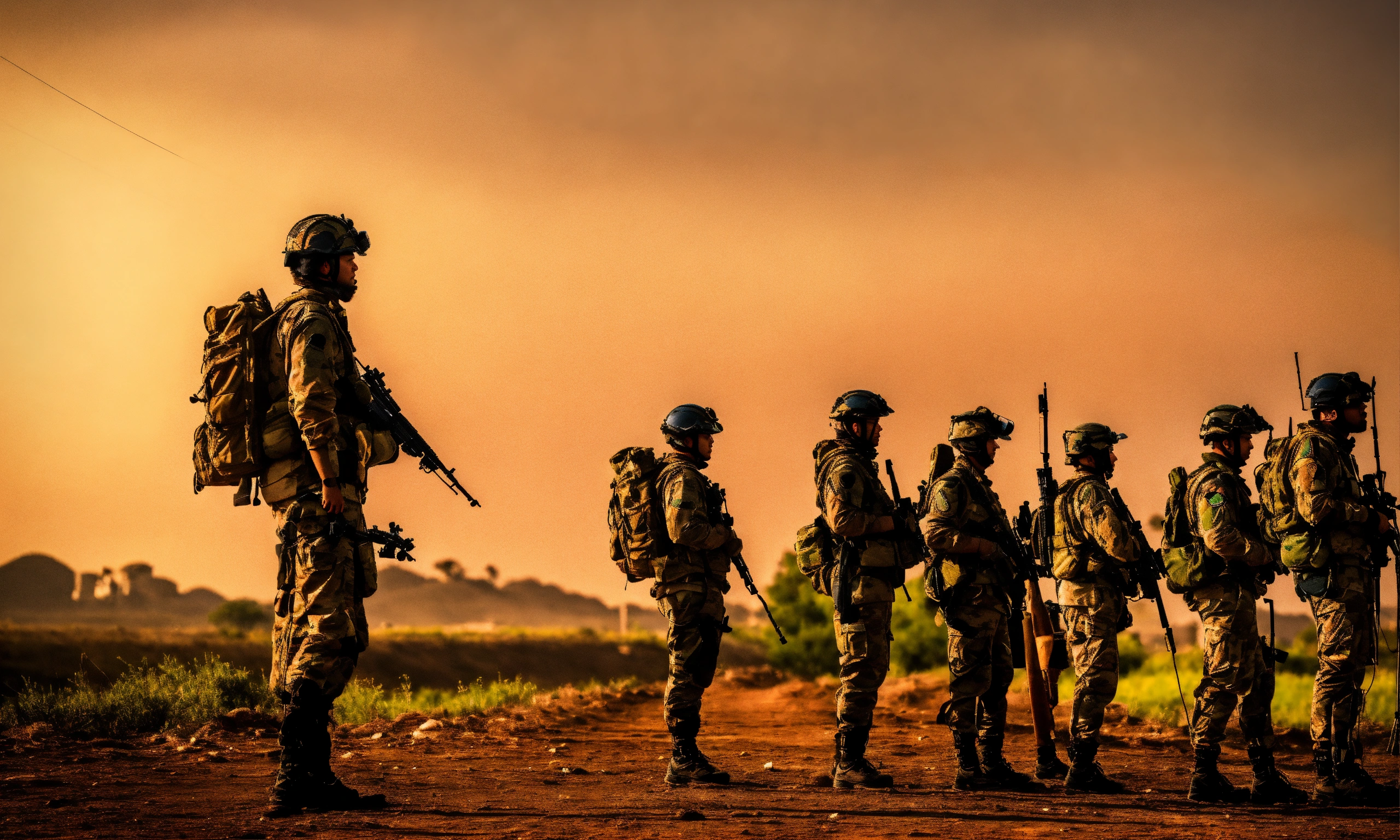Military Tactics
From Sun Tzu to Clausewitz: The Timeless Lessons of Military Tactics

Throughout history, military leaders have consistently turned to two of the greatest strategic minds to shape their tactics and approach to warfare: Sun Tzu and Carl von Clausewitz. These two influential figures, although centuries apart in their respective eras, have left a lasting legacy that continues to shape military strategy to this day.
Sun Tzu, a Chinese general and military strategist who lived in the 6th century BC, is best known for his seminal work, The Art of War. In this timeless text, Sun Tzu outlines the fundamental principles of warfare, emphasizing the importance of careful planning, deception, and the use of psychological tactics to achieve victory on the battlefield. Sun Tzu’s teachings have been used by military leaders throughout history, from ancient Chinese dynasties to modern-day conflicts.
Clausewitz, on the other hand, was a Prussian general and military theorist who wrote On War, a comprehensive treatise on military strategy and the nature of warfare. Published in the early 19th century, Clausewitz’s work expanded upon Sun Tzu’s ideas and introduced new concepts, such as the fog of war and the importance of political considerations in military decision-making. Clausewitz’s theories have had a profound influence on military thinkers, including Napoleon Bonaparte and modern-day military strategists.
While Sun Tzu and Clausewitz came from vastly different cultural and historical backgrounds, their teachings share many similarities. Both emphasize the importance of understanding the enemy’s strengths and weaknesses, adapting to changing circumstances, and maintaining a clear sense of purpose and direction in the face of adversity. These timeless lessons have guided military leaders for centuries and continue to be relevant in today’s increasingly complex and unpredictable world.
In recent years, the principles of Sun Tzu and Clausewitz have been applied to a wide range of military conflicts, from conventional warfare to counterinsurgency operations. The lessons of these two great strategists have proven invaluable in shaping the tactics and strategies of modern military forces, helping them to adapt and succeed in the face of evolving threats and challenges.
In conclusion, the teachings of Sun Tzu and Clausewitz offer timeless lessons that continue to shape military tactics and strategy to this day. By studying and applying the principles outlined by these two great strategic minds, military leaders can gain a deeper understanding of the nature of warfare and improve their chances of achieving victory on the battlefield. From ancient battles to modern conflicts, the wisdom of Sun Tzu and Clausewitz remains as relevant and important as ever.
Military Tactics
Understanding the Principles of Military Tactics for Success in Combat

Military tactics are the strategies and techniques used by armed forces to achieve victory in combat. Understanding the principles of military tactics is essential for success on the battlefield and can mean the difference between victory and defeat. In this article, we will explore the fundamental principles of military tactics and how they can be applied to achieve success in combat.
One of the most important principles of military tactics is the concept of surprise. Surprise can give a significant advantage to a military force by catching the enemy off guard and disrupting their plans. This can be achieved through various means, such as launching a surprise attack, using deception to mislead the enemy, or utilizing unconventional tactics to confuse and disorient the enemy. By maintaining the element of surprise, a military force can gain the upper hand and quickly overpower their opponents.
Another key principle of military tactics is the use of terrain to one’s advantage. Terrain plays a crucial role in determining the outcome of a battle, as it can provide cover and concealment for troops, impede the movement of enemy forces, and offer strategic vantage points for observation and attack. By carefully analyzing the terrain and exploiting its features, a military force can position themselves in a favorable position to engage the enemy and gain a tactical advantage.
Unity of command is also an essential principle of military tactics. In combat, it is crucial for all units to act cohesively under a single commander in order to achieve a common objective. By maintaining a unified chain of command, military forces can coordinate their actions, respond swiftly to changing situations, and execute their plans effectively. Fragmentation of command can lead to confusion, disorganization, and ultimately, failure on the battlefield.
Additionally, the principle of mass and concentration of force is critical for success in combat. By concentrating their forces at a decisive point, a military force can overwhelm the enemy and achieve a breakthrough in their defenses. This requires careful coordination and synchronization of multiple units to maximize their combat power and achieve a decisive advantage. By massing their forces at the right place and time, a military force can deliver a crushing blow to the enemy and achieve victory on the battlefield.
Lastly, adaptability and flexibility are key principles of military tactics. In combat, situations can change rapidly, and it is essential for military forces to adapt to evolving circumstances and make quick decisions in response to new threats and opportunities. By remaining flexible and adjusting their plans as needed, a military force can outmaneuver the enemy, exploit their weaknesses, and achieve success in combat.
Overall, understanding and applying the principles of military tactics is essential for success in combat. By maintaining the element of surprise, utilizing terrain to one’s advantage, maintaining unity of command, concentrating forces at a decisive point, and remaining adaptable and flexible in the face of changing circumstances, military forces can achieve victory on the battlefield and achieve their strategic objectives. By mastering these fundamental principles, military leaders can lead their forces to success in combat and achieve victory over their adversaries.
Military Tactics
Winning Hearts and Minds: The Psychological Aspect of Military Tactics

Winning hearts and minds is a concept that has been a fundamental part of military strategy for centuries. Originally coined during the Vietnam War, the phrase refers to the idea that military success is not solely determined by destroying enemy forces, but also by winning over the support of civilians and gaining their trust and loyalty.
In modern warfare, winning hearts and minds has become an essential psychological aspect of military tactics. The success of a military campaign is no longer just about defeating the enemy on the battlefield, but also about shaping the perceptions and attitudes of the local population. This can be achieved through a variety of tactics, including humanitarian aid, outreach programs, and communication strategies.
One of the key benefits of winning hearts and minds is that it can help to reduce civilian casualties and limit collateral damage. By gaining the trust and support of the local population, military forces can more effectively target enemy combatants and avoid causing harm to innocent civilians. This not only helps to minimize the human cost of war but also increases the legitimacy of the military campaign in the eyes of the international community.
Another important aspect of winning hearts and minds is the impact it can have on the morale of both military forces and the local population. When soldiers feel that they are fighting for a just cause and have the support of the civilian population, they are more likely to remain motivated and committed to their mission. Similarly, when civilians feel that they are being protected and supported by military forces, they are more likely to cooperate and provide valuable intelligence that can help to defeat the enemy.
Furthermore, winning hearts and minds can also contribute to long-term stability and security in conflict-affected areas. By building relationships with local communities and addressing their needs and grievances, military forces can help to create a more favorable environment for peacebuilding and reconstruction efforts. This can ultimately lead to a more sustainable and lasting resolution to the conflict.
However, winning hearts and minds is not without its challenges. It requires a deep understanding of the local culture, customs, and traditions, as well as the ability to build trust and rapport with the civilian population. It also requires patience and perseverance, as changing perceptions and attitudes can take time and effort.
In conclusion, the psychological aspect of military tactics, such as winning hearts and minds, is essential for achieving success on the battlefield and creating long-term stability in conflict-affected areas. By prioritizing the well-being and support of the civilian population, military forces can not only defeat the enemy but also build a foundation for lasting peace and security.
Military Tactics
Surgical Strikes and Precision Warfare: The Future of Military Tactics

In recent years, there has been a growing trend towards surgical strikes and precision warfare as the preferred military tactics for many countries around the world. This shift in strategy has been driven by advancements in technology, improved intelligence capabilities, and a desire to minimize collateral damage and civilian casualties during military operations.
Surgical strikes are defined as targeted military attacks aimed at a specific target or group of targets. These strikes are designed to achieve a specific objective with minimal collateral damage and are often carried out with precision-guided weapons and the use of advanced intelligence, surveillance, and reconnaissance capabilities. The goal of surgical strikes is to neutralize a specific threat or achieve a specific military objective without escalating the conflict or causing undue harm to civilians.
Precision warfare, on the other hand, refers to the use of advanced technologies such as drones, guided missiles, and smart bombs to accurately target and destroy enemy assets. This type of warfare allows for precise and effective strikes against enemy forces, infrastructure, and command and control centers, while minimizing the risk to friendly forces and civilians.
The shift towards surgical strikes and precision warfare has been driven by several factors. Firstly, advances in technology have made it possible to conduct precise military operations with a high degree of accuracy. In the past, military operations were often characterized by large-scale bombing campaigns that caused significant collateral damage and civilian casualties. However, with the advent of precision-guided weapons and improved intelligence capabilities, military forces are now able to target specific enemy assets with pinpoint accuracy.
Secondly, the increasingly interconnected and high-tech nature of modern warfare has created new challenges for military planners. Traditional military tactics such as large-scale ground invasions and prolonged campaigns are no longer as effective in the face of asymmetric threats, non-state actors, and complex urban environments. Surgical strikes and precision warfare allow military forces to adapt to these new challenges and respond quickly and decisively to emerging threats.
Lastly, the desire to minimize civilian casualties and collateral damage during military operations has also played a significant role in the rise of surgical strikes and precision warfare. In today’s interconnected world, the impact of civilian casualties and collateral damage can have far-reaching political, diplomatic, and humanitarian consequences. By conducting targeted and precise military operations, military forces can reduce the risk of civilian casualties and limit the negative consequences of their actions.
In conclusion, surgical strikes and precision warfare are shaping the future of military tactics by allowing for targeted and efficient military operations that achieve specific objectives with minimal collateral damage. As technology continues to advance and the nature of warfare evolves, it is likely that these tactics will become even more prominent in military planning and operations. The ability to conduct precise and effective military strikes will be crucial for navigating the complexities of modern warfare and addressing the myriad challenges that military forces face in the 21st century.
